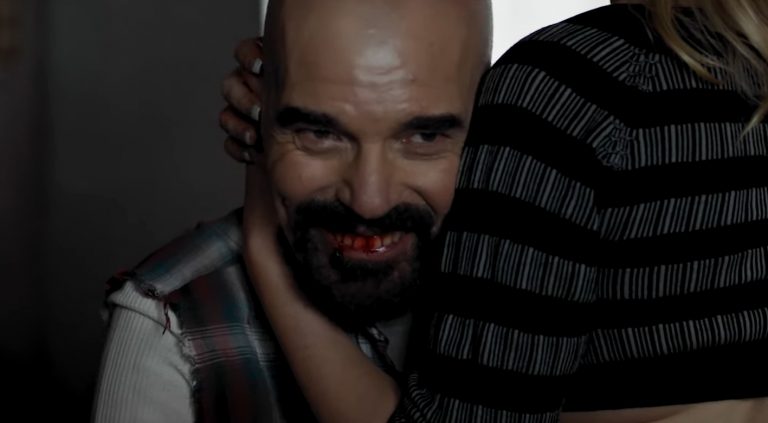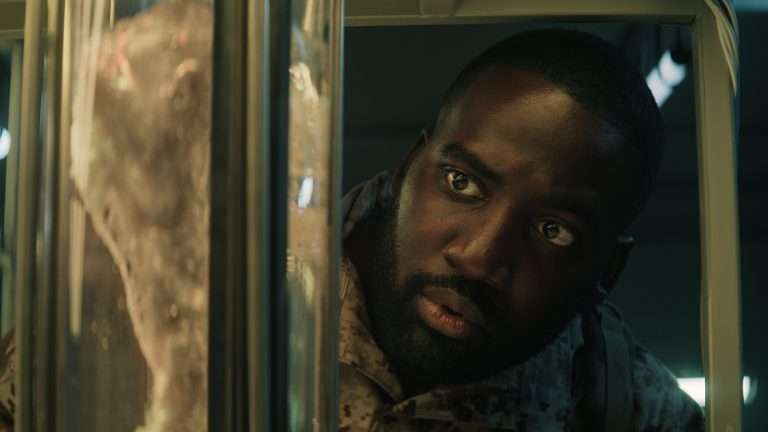Based on William Lindsay Gresham’s 1946 novel of the same name, Guillermo del Toro directed Nightmare Alley (2021) by breaking away from his significant and long-established film-making strategies. When we consider his other directional pieces, such as Crimson Peak (2015) or Pan’s Labyrinth (2006), we observe the ecstasy of fantasy and a depiction of self-indulgence. However, Nightmare Alley undoubtedly confounds our minds without much of his well-known pinch of spices. Illustrated in the neo-noir touch, this film is considered as one of the finest and darkest from the filmmaker’s closet.
Nightmare Alley is the second film adaptation of Gresham’s novel, following the 1947 film of the same name, in which the central character escaped from the pity of life and ran behind the cupidity. Although both films are set in World War II, the poignant saga of the protagonist Stanton Carlisle in del Toro’s vision reminds us of Macbeth, one of William Shakespeare’s greatest tragic heroes, especially due to the meticulous detailing and tremendous psycho-painting of the character. How intense is it? Let’s find out.
Film Noir, is without a doubt, one of the most fascinating, enigmatic, and exciting genres in cinema history. Noir is not only about polishing a hazy mirror to reflect light beams passing through a dark quandary, but it’s also about delving into the depths of its characters. In a Noir film, we cannot separate the dark and light sides of characters, but we can certainly gain insight into the blended verges where traditional definitions of good and evil become incoherent. Stanton Carlisle, our protagonist, is no different.
The Great Escape of Stanton Carlisle
The narrative is set in the Pre-World War II scenario. The story fastens its seat-belt with the protagonist Stanton ‘Stan’ Carlisle (Bradley Cooper) who manages to dump a fastened object – his father’s corpse – after tiresomely dragging it into a makeshift hole, made in the floor of his decrepit home. Moments later, Stanton leaves, setting the house on fire. In this very first scene, we see Stan pulling his father’s body with utter calmness. The way his lips hold the cigarette during his drag clearly depicts that his brain is smoked up to maintain this undisturbed serenity. There is no rush in any of the visuals until he gets off the bus.. Stan, without a doubt, is a level-headed fox who does not engage in any risky behavior.
How The Last Stop Takes Stan To The Carnival?
He boards a bus and wakes up at the last stop. Stan is always inquisitive. All his wicked or not-so-wicked deeds occurred because of this greatest quality. Getting down from the bus, he heads towards the café, but when he sees a dwarf man (Mark Povinelli) walking in the opposite direction, towards the carnival, he changes his path. He eventually follows that man into the carnival and discovers several shows. His attention is drawn to a remarkable poster titled “Odd-i-torium,” where the anchor claims to show the missing link between a wild beast and a civilised human, entrapped in their cages. Stan enters the show organised by Clement “Clem” Hoately (Willem Dafoe), the carnival’s owner, without a penny in his pocket and witnesses how the horrific “geek” eats a chicken, tearing it apart from its neck.
No matter what, Stan is always curious; drawn to the unknown and uncanny, whether it is filthy or beautiful. He tries to flee the show, but is apprehended by Bruno (Ron Perlman), who asks him to assist in relocating their belongings to another location due to the stormy climate. Stan eventually agrees to stay and work there in exchange for food and shelter. When he first sees Molly (Rooney Mara), his attention is instantly drawn to her. So, it goes without saying that Stan never passes up an opportunity.. He never knows what’s coming next, but knows how to utilize the now. Over time, he takes advantage of opportunities that come his way, while also creating his own.
Carnival Was Never The Last Stop For The Farsighted Stan
The next morning, waking up from a disturbing dream about his father and the bloody geek, Stan encounters a mind-reader couple, Zeena Krumbein (Toni Collette), and her alcoholic husband, Peter “Pete” (David Strathairn) while looking for a bathroom. In the blink of an eye, he becomes friendly with them and joins their fortune-telling act at the carnival, most likely due to his flamboyant panache and sensual encounter with Zeena. He persuades Pete to educate him on his clairvoyant abilities, and Pete agrees. Stan’s burgeoning crush on Molly, a fellow carnival performer, takes him to her, and Molly demonstrates how she conducts electricity through her body.
At this point, we can see that empathy is an important aspect of Stan’s character. When he first discovered the geek hiding in the strange cave, he extended his hand as if to a perfectly normal person, without thinking of him as a monster. When he gives that poor man a counter of his cigarettes, we can see that he has a lot of sympathy for him. Stan also gives up after a few failed denials when Zeena forces herself over him in the bathtub. Does he like her or does he simply understand Zeena’s unsatisfactory conjugal relationship with her older husband. Stan feels bad even when he has to leave the soaked and sick geek to get medical attention in the rainy evening.

Like most other noir protagonists, Stan is “easy on the eyes”. He is seductive, alluring, convincing, and even manipulative. Stan’s empty pockets and stomach are now full. However, his growing desire for power and prestige prevents him from relaxing and living a peaceful life there. Instead, after Pete dies unexpectedly, Stan leaves the carnival to become an independent mentalist, taking Molly with him after successfully convincing her in the sweetest way possible. Stan is a quick learner. He is enthusiastic about learning new skills. Before his death, Stan convinces Pete to be his mentor. Soon, thanks to Stan’s hard and smart work, he gets a good grasp on human psychology. He transforms himself into a promising mentalist and convinces the sheriff with his instant equanimity, and even saves the entire carnival.
Life Changes, Psyche Does Not
After two years, we learn that the duo has become wealthy and is performing in major cities. But their marriage has deteriorated. Stan’s downfall begins when he stumbles upon the psychologist Dr. Lilith Ritter (Cate Blanchett). His lust for wealth becomes so insatiable that he uses the personal information of Lilith’s patients, while pretending to alleviate their mental agony. Stan is a talented artist, but he couldn’t help but express himself in his journal.
In his early days, he won Molly’s heart when he sketched Molly’s portrait. But in the same notebook, she discovers an unfinished sketch of Dr Lilith and is deeply saddened. Stan always wants to improvise things for the better i.e. breaking his own pattern every time. For example, we see his drawing of an electric chair for making Molly’s show more gallant, as well as his idea of teaming up with Lilith in order to present his lies in a more credible manner.
However, Stan’s deep psyche is made up of more than just these characteristics. Extreme ambition is one of Stanton Carlisle’s darkest traits. Stan is no longer that simple boy-next-door after two years in New York City. Moreover, his need and greed have grown exponentially. He misuses Pete’s diary, which details the mentalist’s tricks and ideas. Though he started from nothing and had a good goal of overcoming poverty, his unrelenting rapacity causes him to fail. Furthermore, his irrational desire for money and prestige is so strong in him that he is unconcerned about how the lies affect his audiences. Alas, the public worships his power without having the slightest clue of how Stan’s years of arduous training and expertise have made them transparent.
Why did Stan’s Father die?
The usually empathetic Stan shows no empathy towards people when it comes to his mental games, creating a grey sketch of his peculiar character with a blend of black and white. Of course, Stan kills his father by taking away the old man’s blanket and by opening the window on a chilly day. The intention to kill his father came out of a deep loathing for the man as he was an alcoholic and a burden on his mother.
After growing up in a broken family and being abused by his mother’s lover, he blamed his father for everything. He murders his father, burns the house and his body. But Stan kept his father’s watch so that he can never forget the scars deep within. We see him distressed when he dreams of his father, which indicates that he feels guilty about the transgression. He could have set fire to the watch with the house, but he preferred to wear his agony and guilt on his wrist, creating a striking but painful image of his erratic persona.
Is Pete’s Death An Accident?
His rage toward father figures persists. In order to obtain Pete’s secret diary, he injects him with the toxic Wood spirit, which kills him but leaves Stan in doubt. Stan’s extraordinary wit exposes Pete’s weak spots, such as trust and alcohol, and he exploits them. All Stan wants is to get his hands on the diary and see what’s inside. Despite admitting to Lilith that he gave the wrong alcohol by accident, we know that he was aware of the location of both bottles. So we can strongly presume that Stan killed Pete in a cool-headed manner. Perhaps, because he unwittingly harbored a burning hatred for someone who resembles his father.
Life Happened To Stan, Perfectly
Stan never intends to be an alcoholic like his father, but he becomes one. He is caught up in Lilith’s devious plan, forcing him to seek refuge in a drink. Another weak point of Stan is overconfidence. He believes that he is no less potent than Almighty, after a period of consistent accomplishment. Stan goes on doing spooky shows, playing with innocent people’s minds and he never thinks he will ever lose. He generalizes everyone in his line of sight and his exorbitant arrogance takes him to hell. Eventually, he isn’t concerned about Lilith, Molly, or any other familiar faces because he believes they are “not powerful enough.”
Blinded by smugness, Stan not only turns a deaf ear to Zeena’s concern about the last card he draws, but also casually inverts that very card. He is so convinced of his lies that he easily passes a lie detection test.His physiological indicators are synchronized with his lies, which emphasizes San became a man of lies. When his train of lies takes two lives of innocent Judge Charles Kimball and his wife Felicia, he is no longer an imposter but also a murderer.
Stan dupes his wife Molly into pretending to be Ezra’s deceased girlfriend Dorrie. Unfortunately, the show fails miserably, and to add insult to injury, Lilith betrays Stan for full-fledged vengeance with his polished knowledge. Karma strikes back, sending Stan back on the road, hungry and unbalanced. He approaches another carnival owner in search of work. But instead receives a “temporary” offer to work as a geek, completing the Circle of Stan’s life. Finally, we see him selling his guilt piece, his father’s watch for alcohol, which symbolizes that time is no longer with him.
Conclusion
Caged inside a mind full of lies, Stan never realized the consequences of the dangerous game he played by having Molly pose as Dorrie in front of Ezra. He never considered the possibility of being apprehended. He was never interested in understanding the mind; instead, he sought to deceive others and himself. His only goal was to profit from other people’s trauma, not to investigate it himself. So, last but not the least, with greed as opium tincture and Lie as chicken, Stanton Carlisle finally became the geek because he was “born for it”

![Adaptation [2002]: Eternal Sunshine of a Screenwriter’s Mind](https://79468c92.delivery.rocketcdn.me/wp-content/uploads/2017/06/maxresdefault-1-768x432.jpg)


![A Hidden Life [2019] Review: Terrence Malick’s Finest In Ages](https://79468c92.delivery.rocketcdn.me/wp-content/uploads/2020/01/A-Hidden-Life-768x432.jpg)

![Mr. Thank You [1936] Review – A Bittersweet and Deeply Humane Road Movie Classic](https://79468c92.delivery.rocketcdn.me/wp-content/uploads/2019/12/Mr.-Thank-You-1936-768x576.jpeg)